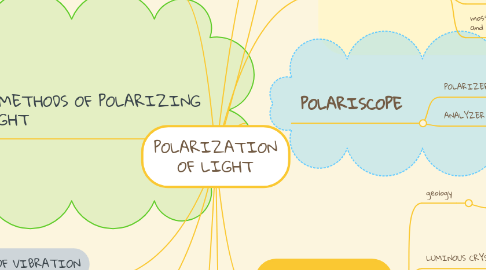
1. METHODS OF POLARIZING LIGHT
1.1. Polarization by Transmission
1.2. Polarization by Reflection
1.3. Polarization by Refraction
1.4. polarization by Scattering
2. Your Ideas Here!
3. PLANE OF VIBRATION
3.1. the plane that contains the polarized light
4. PLANE OF POLARIZATION
4.1. the plane perpendicular to the plane of vibration
5. BREWSTER'S LAW
5.1. states that when a light incident at a polarizing angle θp at the interference of a transparent medium, the refractive index of the medium with respect to the surrounding medium is equal the tangent of the polarizing angle
6. MALUS' LAW
6.1. states that when a completely plane polarized light is incident on an lyzer
7. VIDEO
8. polarization
8.1. it is the process of transforming unpolarized light into polarized light
8.2. he process of transforming unpolarized light into polarized light
9. light waves
9.1. it is an electromagnetic wave that is TRANSVERSE in nature.
9.2. are created by electric charges that vibrate in a VARIETY OF DIRECTIONS, thus creating an electromagnetic wave that vibrates in a variety of directions
9.3. most light sources like bulbs, lamps, and candles are UNPOLARIZED
10. polarized light
10.1. Polarized light waves are light waves in which the vibrations occur in a single plane
10.1.1. LINEAR POLARIZATION
10.1.1.1. the electric field of light is confined to a single plane along the direction of propagation.
10.1.2. ELLIPTICAL POLARIZED
10.1.2.1. the electric field of light describes an ellipse.
10.1.3. CIRCULAR POLARIZED
10.1.3.1. the electric field of light consists of two linear components that are perpendicular to each other, equal in amplitude, but have a phase difference of π/2
11. unpolarized light
11.1. A light wave that is vibrating in more than one plane.
12. POLARISCOPE
12.1. POLARIZER
12.1.1. instrument where light gets polarized
12.1.1.1. ex: polaroid filters
12.2. ANALYZER
12.2.1. an instrument that detects whether a light ray is polarized or not
13. APPLICATIONS
13.1. geology
13.1.1. uses polarization microscope for identifying minerals
13.2. LUMINOUS CRYSTAL DISPLAY(LCD)
13.2.1. clocks
13.2.2. wrist watches
13.2.3. timers
13.2.4. computer and televison screens
13.3. entertainment
13.3.1. use of polarized glasses in watching 3D movies
13.4. communication
13.4.1. use of vertical polarization in radiating radio signals in different directions

